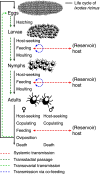The evolving story of Borrelia burgdorferi sensu lato transmission in Europe
- PMID: 35122516
- PMCID: PMC8816687
- DOI: 10.1007/s00436-022-07445-3
The evolving story of Borrelia burgdorferi sensu lato transmission in Europe
Abstract
Beside mosquitoes, ticks are well-known vectors of different human pathogens. In the Northern Hemisphere, Lyme borreliosis (Eurasia, LB) or Lyme disease (North America, LD) is the most commonly occurring vector-borne infectious disease caused by bacteria of the genus Borrelia which are transmitted by hard ticks of the genus Ixodes. The reported incidence of LB in Europe is about 22.6 cases per 100,000 inhabitants annually with a broad range depending on the geographical area analyzed. However, the epidemiological data are largely incomplete, because LB is not notifiable in all European countries. Furthermore, not only differ reporting procedures between countries, there is also variation in case definitions and diagnostic procedures. Lyme borreliosis is caused by several species of the Borrelia (B.) burgdorferi sensu lato (s.l.) complex which are maintained in complex networks including ixodid ticks and different reservoir hosts. Vector and host influence each other and are affected by multiple factors including climate that have a major impact on their habitats and ecology. To classify factors that influence the risk of transmission of B. burgdorferi s.l. to their different vertebrate hosts as well as to humans, we briefly summarize the current knowledge about the pathogens including their astonishing ability to overcome various host immune responses, regarding the main vector in Europe Ixodes ricinus, and the disease caused by borreliae. The research shows, that a higher standardization of case definition, diagnostic procedures, and standardized, long-term surveillance systems across Europe is necessary to improve clinical and epidemiological data.
Keywords: Borrelia; Ixodes; Lyme borreliosis; Lyme disease; Spirochetes; Tick; Tick-borne diseases.
© 2022. The Author(s).
Conflict of interest statement
The authors declare no competing interests.
Figures



References
-
- Afzelius A. Erythema chronicum migrans. Acta Derm Venereol. 1921;2:120–125.
-
- Allan BF, Keesing F, Ostfeld RS. Effect of forest fragmentation on Lyme disease risk. Conserv Biol. 2003;17:267–272. doi: 10.1046/j.1523-1739.2003.01260.x. - DOI
-
- Altobelli A, Boemo B, Mignozzi K, Bandi M, Floris R, et al. Spatial Lyme borreliosis risk assessment in north-eastern Italy. Int J Med Microbiol. 2008;298:125–128. doi: 10.1016/j.ijmm.2008.05.005. - DOI
Publication types
MeSH terms
LinkOut - more resources
Full Text Sources
Medical
Research Materials

